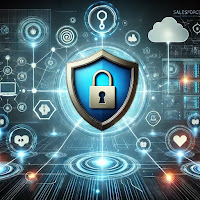A Cybersecurity Professional’s Guide to Salesforce
Introduction
Salesforce is one of the world’s most popular Customer Relationship Management (CRM) platforms, helping organizations manage customer data, sales pipelines, marketing efforts, and service operations. While it’s a powerful tool for business growth, it also presents unique cybersecurity challenges that professionals must address.
If you’re a cybersecurity professional with little to no experience with Salesforce, this guide will help you understand its security model, potential risks, and best practices for keeping data safe.
What is Salesforce?
At its core, Salesforce is a cloud-based CRM platform that enables businesses to store customer data, automate workflows, and integrate with various third-party applications. Unlike traditional software installed on local servers, Salesforce operates as a Software-as-a-Service (SaaS) solution, meaning data is hosted on the cloud using a multi-tenant architecture.
Why Does Salesforce Security Matter?
Because Salesforce holds sensitive customer information, including personal data, financial records, and business intelligence, it becomes a prime target for cyberattacks, insider threats, and compliance risks. Cybersecurity professionals must ensure that Salesforce environments are configured securely to prevent data breaches and unauthorized access.
Key Security Considerations in Salesforce
1. Data Security & Access Control
Salesforce provides several granular access controls to limit who can view or modify specific data:
- Profiles & Permission Sets: Define user permissions at the object and field level.
- Roles & Sharing Rules: Control data access across an organization based on hierarchy and need-to-know principles.
- Field-Level & Object-Level Security: Prevent unauthorized users from viewing or editing sensitive information.
- Org-Wide Defaults (OWD): Define the baseline access level for records across the organization.
Misconfigurations in these settings can expose sensitive data to unauthorized users, making proper access control a top priority.
2. Authentication & Identity Management
To prevent unauthorized logins, Salesforce enforces robust authentication mechanisms, including:
- Multi-Factor Authentication (MFA): Required for all users to add an extra layer of security.
- Single Sign-On (SSO): Integrates with corporate identity providers using SAML, OAuth 2.0, or OpenID Connect.
- Login IP Ranges & Session Security: Restrict user access based on trusted locations and session timeouts.
Without these safeguards, attackers can exploit weak authentication methods to gain access to customer data.
3. Data Encryption & Compliance
Salesforce provides encryption-at-rest and in-transit to protect data, but for organizations with strict compliance requirements (SOC 2, ISO 27001, HIPAA, GDPR), additional security measures are necessary:
- Salesforce Shield: Advanced encryption, real-time event monitoring, and field audit trails.
- Platform Encryption: Ensures sensitive data is unreadable without decryption keys.
A failure to implement proper encryption policies can lead to regulatory violations and financial penalties.
4. Threat Detection & Monitoring
Monitoring Salesforce activity is crucial for detecting potential security threats, such as unauthorized logins, data exfiltration, or privilege escalation.
- Security Health Check: Analyses your Salesforce security settings and provides recommendations.
- Event Monitoring: Tracks user activity, API calls, and login attempts in real-time.
5. API & Third-Party Integrations
Salesforce is designed to integrate seamlessly with third-party applications and external systems through APIs. However, improper API security configurations can lead to data leaks, unauthorized access, and potential breaches.
Key API Security Best Practices:
- Use OAuth Tokens: Avoid hardcoding credentials; use OAuth 2.0 for secure authentication.
- Restrict API Access: Apply IP whitelisting and session controls to prevent unauthorized requests.
- Monitor API Calls: Track excessive or suspicious API activity to detect potential data exfiltration.
- Limit Third-Party App Permissions: Review AppExchange integrations and grant only the minimum necessary access.
Cybercriminals often target APIs as an entry point for attacks, so securing them is crucial for protecting Salesforce data.
Best Practices for Securing Salesforce
To reduce risk and strengthen Salesforce security, cybersecurity professionals should implement the following best practices:
1. Enforce Strong Authentication Policies
- Require MFA for all users.
- Implement SSO with secure identity providers.
- Restrict logins based on IP ranges and trusted networks.
2. Apply the Principle of Least Privilege (PoLP)
- Assign roles, profiles, and permission sets based on job functions.
- Regularly audit user access levels to prevent excessive permissions.
3. Monitor Security Logs & Anomalous Activity
- Use Salesforce Event Monitoring to track suspicious behaviour.
- Integrate logs with SIEM solutions for real-time threat detection.
- Set up alerts for failed login attempts and unusual API calls.
4. Secure Data with Encryption & Backup Strategies
- Enable Salesforce Shield for advanced encryption.
- Regularly back up data using native or third-party solutions.
- Ensure compliance with industry regulations (GDPR, HIPAA, etc.).
5. Assess & Audit Security Settings Regularly
- Conduct quarterly Salesforce security health checks.
- Review and disable inactive user accounts.
- Remove unnecessary third-party app integrations.
Salesforce is a powerful CRM platform, but its security risks must not be overlooked. As a cybersecurity professional, understanding authentication controls, data protection mechanisms, API security, and monitoring tools is essential to safeguarding sensitive information.
By implementing best practices, regularly auditing security settings, and proactively monitoring threats, organizations can ensure that their Salesforce environments remain secure and compliant.
Next Steps
- Learn more about Salesforce basics with the Admin Trailmix
- Explore Salesforce Security Best Practices documentation.
- Take Salesforce Trailhead courses on security fundamentals.
- Details on testing your solution
Useful Tools
- Salesforce Code Analyzer
- CheckMarx Unmanaged Code Scanner
- Conduct a Salesforce Security Health Check within your organization.
If you have experience securing Salesforce environments, what additional security measures do you recommend? Share your insights in the comments below!

Comments